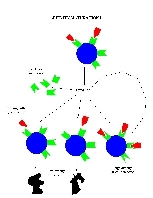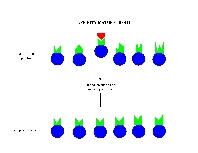| Introduction |
| Recognition of the Immune System |
| Generating Receptor Diversity |
| Affinity Maturation |
| Organizing Principles |
| Possible Architectures |
| Artificial Immune System |
| Summary |
Affinity Maturation |
To cover the space of all possible nonself patterns adequately requires a huge diversity of lymphocyte receptors, with relatively low affinity thresholds. This enables the immune system to detect just about any pathogen, but the detection may take some time, during which the pathogen will be replicating and causing harm. The immune system needs to be able to both detect and eliminate pathogens as quickly as possible. Generalized lymphocytes will not be very fast at detecting specific pathogens, nor very efficient at capturing them.
How does the immune system ensure that lymphocytes can rapidly detect specific pathogens, and capture them efficiently?
The immune system incorporates mechanisms that enable lymphocytes to learn the structures of specific foreign proteins; essentially, the immune system evolves and reproduces lymphocytes that have high affinities for specific pathogens.
How does the immune system learn to recognize specific pathogens?
 Figure . Activated B-cells produce antibodies and mutated
clones, which are subject to selection via pathogen affinities.
Figure . Activated B-cells produce antibodies and mutated
clones, which are subject to selection via pathogen affinities.
Through a process called affinity maturation, which is essentially a Darwinian process of variation and selection (see figure ). Affinity maturation involves a subset of lymphocytes, called B-cells because they mature in the bone marrow. When a B-cell is activated (its affinity threshold is exceeded), by binding to pathogens, it does two things. Firstly, it secretes a soluble form of its receptors, called antibodies, which bind to pathogens and inactivate them, or identify them to phagocytes and other innate system defenses, which allows the innate system to eliminate them. Secondly, the B-cell clones itself, but the copies producted by this cloning are not perfect. Cloning is subject to very high mutation rates, called somatic hypermutation, which can result in daughter cells that have somewhat different receptors from the parent. These new B-cells will also have the opportunity to bind to pathogens, and if they have a high affinity for the pathogens, they in turn will be activated and cloned. The higher the affinity of a B-cell for pathogens present, the more likely it is that the B-cell will clone; B-cells end up competing for available pathogens, with the highest affinity B-cells being the "fittest" and hence replicating the most. Thus the variation is provided by hypermutation, and the selection is provided by competition for pathogens.
 Figure . Affinity maturation is a
Darwinian process of variation and selection.
Figure . Affinity maturation is a
Darwinian process of variation and selection.
As a population of B-cells undergoes affinity maturation, it evolves B-cells with higher pathogen affinity, i.e. B-cells that are more efficient at detecting and capturing the pathogens (see figure ). This is essential when fighting off a replicating pathogen: we can view this as an arms race between B-cell reproduction and pathogen replication.